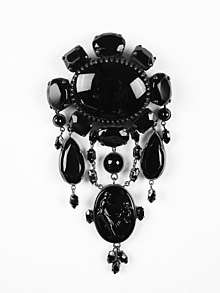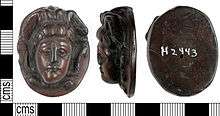Jet (gemstone)
Jet is a type of lignite,[1] the lowest rank of coal, and is a gemstone. Unlike many gemstones, jet is not a mineral, but is rather a mineraloid.[2] It is derived from wood that has changed under extreme pressure.
| Jet | |
|---|---|
Sample of unworked jet, about 15 mm long | |
| General | |
| Category | Mineraloid |
| Identification | |
| Color | Black, occasionally brown |
| Cleavage | None |
| Fracture | Conchoidal |
| Tenacity | Brittle |
| Mohs scale hardness | 2.5-4.0 |
| Streak | Brown |
| Specific gravity | 1.3-1.4 |
| Optical properties | Isotropic |
| Refractive index | 1.640 to 1.680 |
| Dispersion | None; opaque |
| Ultraviolet fluorescence | None |
| Common impurities | Iron, sulfur |
| References | |


The English noun "jet" derives from the French word for the same material, jaiet (modern French jais), ultimately referring to the ancient town of Gagae.[3] Jet is either black or dark brown, but may contain pyrite inclusions,[4] which are of brassy colour and metallic lustre. The adjective "jet-black", meaning as dark a black as possible, derives from this material.
Origin
Jet is a product of high-pressure decomposition of wood from millions of years ago, commonly the wood of trees of the family Araucariaceae. Jet is found in two forms, hard and soft. Hard jet is the result of carbon compression and salt water; soft jet is the result of carbon compression and fresh water.
Location
The jet found at Whitby, in England, is the "Jet Rock" unit of the Mulgrave Shale Member, which is part of the Whitby Mudstone Formation. This jet deposit was formed approximately 181 million years ago, during the Toarcian age of the Early Jurassic epoch.[5][6][7] Whitby Jet is the fossilized wood from species similar to the extant Chile pine or Monkey Puzzle tree (Araucaria araucana).[8]
The jet found in Asturias, the biggest deposit in northern Spain[9], is of Late Jurassic (Kimmeridgian) age, about 155 million years old. Asturian jet is a perhydrous coal that suffered an anomalous coalification process and presents great material stability over long periods of time.[10]
Other locations
Jet is also commercialized in Poland and Santiago de Compostela in northern Spain[11] and near Erzurum in Turkey, where it is used to make prayer beads.[12]
North American jet
Native American Navajo and Pueblo tribes of New Mexico were using regionally mined jet for jewellery and the ornamentation of weapons when early Spanish explorers reached the area in the 1500s.[13] Today these jet deposits are known as Acoma jet, for the Acoma Pueblo. Enormous coal deposits characterize the San Juan Basin of New Mexico and this geology is closely related to jet deposits mined in the Henry Mountains of Utah[14] and the Front Range of El Paso County, Colorado.[15]
History
Jet has been used in Britain since the Neolithic period,[16] but the earliest known object is a 10,000 BC model of a botfly larva, from Baden-Württemberg, Germany, found among the Venuses of Petersfels.[17][16] It continued in use in Britain through the Bronze Age where it was used for necklace beads.[16] During the Iron Age jet went out of fashion until the early-3rd century AD in Roman Britain. The end of Roman Britain marked the end of jet's ancient popularity,[16] despite sporadic use in the Anglo-Saxon and Viking periods and the later Medieval period. Jet regained popularity with a massive resurgence during the Victorian era.[16]
Roman use
Whitby jet was a popular material for jewellery in Roman Britain from the 3rd century onward. It was used in rings, hair pins, beads, bracelets, bangles, necklaces, and pendants,[16] many of which are visible in the Yorkshire Museum. There is no evidence for Roman jet working in Whitby itself,[16] rather it was transferred to Eboracum (modern York) where considerable evidence for jet production has been found.[18] The collection of jet at this time was based on beachcombing rather than quarrying.[16]

In the Roman period it saw use as a magical material, frequently used in amulets and pendants because of its supposed protective qualities and ability to deflect the gaze of the evil eye.[19] Pliny the Elder suggests that "the kindling of jet drives off snakes and relieves suffocation of the uterus. Its fumes detect attempts to simulate a disabling illness or a state of virginity."[20] It has been referenced by other ancient writers including Solinus[21] and Galen.
Around the Rhine some jet bracelets from the period have been found that feature grooves with gold inserts.[22]
Victorian use

Jet as a gemstone became fashionable during the reign of Queen Victoria.[23] It originally became fashionable in the 1850s after the queen wore a necklace of it as part of mourning dress for Princess Victoria of Saxe-Coburg and Gotha.[23] Later the Queen wore Whitby jet as part of her mourning dress while mourning the death of Prince Albert.[8][24][25].
In some jewellery designs of the period jet was combined with cut steel.[26]
Jet continued to be used in jewellery even after the decline of mourning dress in the 1890s.[23]
20th century
In the United States, long necklaces of jet beads were popular during the Roaring Twenties, when women and young flappers would wear strands of jet beads stretching from the neckline to the waistline. In these necklaces, the jet was strung using heavy cotton thread; small knots were made on either side of each bead to keep the beads spaced evenly, much in the same way that fine pearl necklaces are made.
Properties
Jet has also been known as black amber, as it may induce an electric charge like that of amber when rubbed.
Jet is very easy to carve, but it is difficult to create fine details without breaking so it takes an experienced lapidary to execute more elaborate carvings.
Jet has a Mohs hardness ranging between 2.5 and 4 and a specific gravity of 1.30 to 1.34. The refractive index of jet is approximately 1.66. The touch of a red-hot needle should cause jet to emit an odour similar to coal.[27]
Authenticating jet
Although now much less popular than in the past, authentic jet jewels are valued by collectors.
Unlike black glass, which is cool to the touch, jet is not cool, due to its lower thermal conductivity. Glass was used as a jet substitute during the peak of jet's popularity.[28][29] When it was used in this way it was known as French jet or Vauxhall glass.[28][29] Ebonite was also used as a jet substitute and initially looks very similar to jet, but it fades over time.[30] In some cases jet offcuts were mixed with glue and molded into jewelry.[30]
Anthracite (hard coal) is superficially similar to fine jet, and has been used to imitate it. This imitation is not always easy to distinguish from real jet. When rubbed against unglazed porcelain, true jet will leave a chocolate brown streak.
The microstructure of jet, which strongly resembles the original wood, can be seen under 120× or greater magnification.
See also
References
- Neuendorf, K.K.E.; Mehl, Jr., J.P.; Jackson, J.A., eds. (2005). Glossary of Geology (5th ed.). Alexandria, Virginia: American Geological Institute. p. 344.
- Holmes, Ralph J. and Crowningshield, Robert (1983), "Gemology", in Fyfe, Keith (ed.), The Encyclopedia of Mineralogy, Encyclopedia of Earth Sciences Series, Springer, pp. 168–187, doi:10.1007/0-387-30720-6_51, ISBN 978-0-87933-184-9CS1 maint: uses authors parameter (link)
- Oxford English Dictionary (2nd edition) 1989, Oxford, Oxford University Press
- Pye, K. (1985) Electron microscope analysis of zoned dolomite rhombs in the Jet Rock Formation (Lower Toarcian) of the Whitby area, U.K., Geological Magazine, volume 122, pp. 279–286, Cambridge University Press, doi:10.1017/S0016756800031496
- Thibault, N.; Ruhl, M.; Ullmann, C.V.; Korte, C.; Kemp, D.B.; Gröcke, D.R.; Hesselbo, S.P. (2018). "The wider context of the Lower Jurassic Toarcian oceanic anoxic event in Yorkshire coastal outcrops, UK". Proceedings of the Geologists’ Association. 129: 372–391. doi:10.1016/j.pgeola.2017.10.007.
- Cope, J. C. W. (2006) Jurassic: the returning seas - plate 26 and page 339 of Brenchley, P. J. and Rawson P. F. (editors) (2006) The Geology of England and Wales, 2nd edition, London, The Geological Society
- Gradstein, F.M.; Ogg, J.G.; Schmitz, M.D.; Ogg, G.M. (editors) (2012). The Geologic Timescale 2012. Elsevier. p. 765. ISBN 978-0-44-459390-0.CS1 maint: uses authors parameter (link)
- Oliver, N., 2012, A History of Ancient Britain, Phoenix Paperback, ISBN 978-0753828861
- Ward, Gerald W. R. (2008). The Grove Encyclopedia of Materials and Techniques in Art. Oxford University Press. p. 307. ISBN 978-0-19-531391-8.
- Suárez-Ruiz, Isabel; Iglesias, M. J.; Jiménez Bautista, Amalia; Domínguez Cuesta, María José; Laggoun-Défarge, F. (2006). "El azabache de Asturias: características físico-químicas, propiedades y génesis". Trabajos de Geología, 26. ISSN 1988-5172.
- "Some was Polish, but most came from near Santiago de Compostela in northern Spain" Finlay, Victoria. Jewels: A Secret History (Kindle Location 1035). Random House Publishing Group. Kindle Edition.
- "While there is no source of jet anywhere near southwestern Turkey, it can be found in western Anatolia near Erzurum, where there are about six hundred family-run mines in the mountains. They call it oltu-tasi and it is the material from which Muslim prayer-beads are made. Finlay, Victoria. Jewels: A Secret History (Kindle Locations 1054-1056). Random House Publishing Group. Kindle Edition.
- From The Rio To The Sierra: An Environmental History Of The Middle Rio Grande Basin. https://www.fs.fed.us/rm/pubs/rmrs_gtr005/rmrs_gtr005_082_180.pdf. p. 103.CS1 maint: location (link)
- Minerals and Mineral Localities of Utah. https://ugspub.nr.utah.gov/publications/bulletins/b-117.pdf: UTAH GEOLOGICAL AND MINERAL SURVEY. p. 90.CS1 maint: location (link)
- "Jet from El Paso Co., Colorado, USA". www.mindat.org. Retrieved 2019-01-25.
- Allason-Jones, L. 1996, Roman Jet in the Yorkshire Museum, York: Yorkshire Museum. pp. 8–11 ISBN 978-0905807171
- "Venus figures from Petersfels". Archived from the original on 29 September 2016. Retrieved 9 August 2016.
- Ottaway, P., 2004, Roman York, Tempus: Stroud ISBN 978-0752429168
- Henig, M., 1984, Religion in Roman Britain, London, BT Batsford LTD ISBN 978-0312670597
- Pliny the Elder. Natural History (trans. Bostock, J., Riley, H. T.). London: Taylor and Francis. 1855. Chapter 36
- Caius Julius Solinus (2013). "DE MIRABILIBUS MUNDI CAPITULA VII - XXIV". Archived from the original on 2013-02-06. Retrieved 2013-10-31.
- Johns, Catherine (1996). The Jewellery of Roman Britain Celtic and classical Traditions. Routledge. pp. 120–121. ISBN 9780415516129.
- Tolkien, Tracy; Wilkinson, Henrietta (1997). A Collector’s Guide to Costume Jewelry Key Styles and how to recognize them. Firefly Books. p. 52. ISBN 1552091562.
- St. Clair, Kassia (2016). The Secret Lives of Colour. London: John Murray. p. 276–277. ISBN 9781473630819. OCLC 936144129.
- Phillips, Clare (1996). Jewelry from Antiquity to the Present. Thames and Hudson. pp. 148–150. ISBN 978-0500202876.
- Clifford, Anne (1971). Cut-Steel and Berlin Iron Jewellery. Adams & Dart. pp. 21–22. ISBN 9780239000699.
- Richard T. Liddicoat, Jr. Handbook of Gem Identification 1989 GIA press, 12 ed. pg 192
- "Jet necklace and black silk tie". Body arts. Pitt Rivers Museum. 2011. Archived from the original on 16 February 2016. Retrieved 9 February 2016.
- "Tiara". V&A Collections. Victoria and Albert Museum. Archived from the original on 15 February 2016. Retrieved 9 February 2016.
- Phillips, Clare (1996). Jewelry from Antiquity to the Present. Thames and Hudson. p. 150. ISBN 978-0500202876.
External links
| Wikimedia Commons has media related to Jet (lignite). |